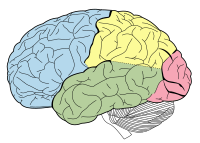
Photo from wikipedia
BACKGROUND AND RATIONALE Magnetoencephalography has emerged as a tool for preoperative evaluation in children. We studied magnetoencephalography characteristics in subtypes of focal cortical dysplasia and correlated the findings with postoperative… Click to show full abstract
BACKGROUND AND RATIONALE Magnetoencephalography has emerged as a tool for preoperative evaluation in children. We studied magnetoencephalography characteristics in subtypes of focal cortical dysplasia and correlated the findings with postoperative seizure outcome. METHODS Inclusion criteria were children ≤18 years who underwent magnetoencephalography during the preoperative evaluation followed by epilepsy surgery and a histopathologic diagnosis of focal cortical dysplasia between February 2008 and February 2013. Patient demographics, MRI, video electroencephalography, and magnetoencephalography data were reviewed. Postoperative seizure outcome data were categorized per International League against Epilepsy definitions. RESULTS Of 178 magnetoencephalography studies performed in children during the study period, 33 patients met inclusion criteria. Focal cortical dysplasia type I, II, and III were found on histopathology in 52%, 39%, and 9% of patients, respectively. Thirty patients had positive magnetoencephalography dipoles, including all patients with focal cortical dysplasia type II and III and 82% of patients with focal cortical dysplasia type I. Three patients had magnetoencephalography unique spikes. Brain MRI lesions were noted preoperatively in 21 patients (64%). Twenty-three patients (77%) had surgical resection of magnetoencephalography dipoles and 11 (48%) of them achieved favorable outcome. CONCLUSIONS Magnetoencephalography supplemented scalp electroencephalography data in spike source localization and showed unique spikes in 10% of the focal cortical dysplasia patients. Magnetoencephalography spikes and tight magnetoencephalography clusters were found more frequently in patients with focal cortical dysplasia type II and III as compared with focal cortical dysplasia type I. Presence of an MRI lesion and complete versus incomplete resection of magnetoencephalography cluster did not result in significant difference in postoperative seizure outcome, likely reflecting selection bias of doing magnetoencephalography in only difficult-to-localize epilepsies.
Journal Title: Pediatric neurology
Year Published: 2018
Link to full text (if available)
Share on Social Media: Sign Up to like & get
recommendations!